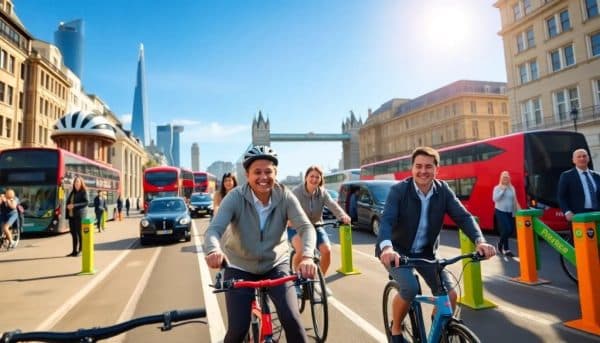In recent years, cycling has gained significant traction as a preferred mode of transportation in London. The rise of bike hire schemes has made cycling more accessible than ever, fundamentally altering the way Londoners commute. This article explores the various ways how bike hire is changing commuting in London, focusing on cost-effectiveness, health benefits, and urban infrastructure.
How is cycling to work in London cost-effective?
Cycling to work in London offers numerous cost savings compared to traditional public transport. For commutes under 10 kilometers, cycling becomes particularly beneficial, as the initial investment in a bike can quickly pay off. By eliminating daily transit fares and reducing expenses associated with maintenance and accessories, many commuters find cycling to be a financially rewarding option.
Moreover, the expenses associated with public transport continue to rise. In contrast, the cost savings of cycling to work in London can be significant, particularly for daily commuters. This economic advantage has led to an increasing number of individuals opting for two wheels over public transport.
With bike hire schemes readily available, even those who don't want to invest in a bicycle can still enjoy the financial benefits of cycling. These initiatives provide a flexible option for commuters, enabling them to pick up a bike when needed without the long-term costs associated with ownership.
What factors influence cycling vs. public transport?
Several key factors influence the choice between cycling and public transport in London. One of the foremost considerations is proximity to transport stations. For individuals living near cycling routes or bike hire stations, cycling becomes an attractive alternative, especially when public transport requires transfers.
Traffic congestion is another significant factor. As London grapples with increasing congestion, cyclists enjoy a distinct advantage. Recent traffic surveys indicate a notable rise in cyclists, reflecting a shift towards sustainable transportation solutions. More people are recognizing that cycling can often be faster than waiting for delayed buses or trains.
- Convenience: Cycling allows for direct routes, avoiding the hassle of transfers.
- Flexibility: Bike hire schemes enable users to choose when and where to ride.
- Environmental impact: Cycling contributes less to pollution compared to public transport.
- Health benefits: Cycling promotes physical health, making it a dual-purpose mode of transport.
How has the pandemic affected cycling in London?
The COVID-19 pandemic has had a profound impact on commuting patterns in London. With many individuals working from home, there has been a notable shift towards cycling as a mode of transport. The impact of cycling on urban transport in London has been evident as more people seek healthier alternatives to crowded public transport.
Government initiatives promoting remote work have accelerated the development of cycling infrastructure, encouraging more Londoners to consider biking as a viable option. New cycle lanes and bike hire schemes have emerged in response to the increased demand for safer cycling options.
As cities adapt to the realities of the pandemic, cycling has become a symbol of resilience and sustainability in urban mobility. The push for greener transportation options aligns with the growing emphasis on public health and environmental awareness.
What are the health benefits of cycling to work?
Cycling is not only a cost-effective mode of transport but also a significant contributor to improved health. The health advantages of cycling for commuters in London are becoming increasingly recognized. Regular cycling can enhance cardiovascular fitness, reduce obesity, and improve mental health.
Studies have shown that cyclists tend to have lower risks of chronic diseases compared to non-cyclists. Furthermore, the physical activity associated with cycling can lead to increased energy levels and productivity throughout the workday.
Additionally, cycling outdoors provides mental health benefits by reducing stress and promoting a sense of well-being. For many Londoners, commuting by bike has become a form of daily exercise, contributing positively to their overall lifestyle.
How is cycling infrastructure evolving in London?
The evolution of cycling infrastructure is crucial to accommodating the increasing number of cyclists in London. Local authorities, under the guidance of Transport for London, are implementing extensive improvements to biking facilities. This includes the expansion of cycle lanes and the promotion of bike hire schemes.
Recent initiatives have focused on creating safer routes for cyclists, reducing the risks associated with urban riding. Enhanced bike parking facilities and dedicated cycling zones are becoming more common in city planning, making cycling a more attractive option for commuters.
- Development of protected cycle lanes.
- Increased bike parking availability.
- Integration of cycling with public transport systems.
- Expansion of bike hire stations across the city.
- Public awareness campaigns promoting cycling benefits.
What role do bike hire schemes play in urban mobility?
Bike hire schemes are foundational to the transformation of urban mobility in London. These initiatives not only provide an affordable alternative to public transport but also encourage a culture of cycling among Londoners. By allowing users to rent bikes on-demand, they eliminate the barriers associated with bike ownership.
Moreover, bike hire schemes contribute significantly to reducing congestion and pollution in urban areas. This aligns with city-wide goals of promoting sustainable transportation and enhancing air quality. More people are choosing to travel by bike, resulting in less reliance on car usage.
As bike hire schemes continue to expand, a cycle-friendly culture is cultivated within the city, encouraging healthy, sustainable commuting options for everyone.
How can cycling help reduce congestion and pollution?
Cycling presents a viable solution to reducing congestion and pollution in densely populated urban areas like London. With increasing traffic congestion, bicycles offer a practical alternative that can help to alleviate pressure on public transport and roads.
By encouraging more individuals to cycle, cities can effectively decrease the volume of vehicles on the road. This shift not only reduces travel times for all commuters but also contributes to lower emissions and improved air quality. The collective impact of cycling can lead to a significant reduction in urban pollution levels.
Furthermore, as more Londoners adopt cycling, the city can better manage its transportation systems, ultimately leading to a more sustainable and livable environment.
Related questions about cycling in London
Why isn't cycling normal in London?
Cycling hasn't been perceived as a standard mode of transport in London primarily due to historical urban planning that favored motor vehicles. Issues such as inadequate cycling infrastructure and safety concerns have discouraged many potential cyclists. However, recent efforts to improve bike lanes and public awareness campaigns are gradually changing this perception.
Is cycling in London increasing?
Yes, cycling in London is on the rise. Recent statistics show a substantial increase in the number of cyclists, especially since the onset of the pandemic. As more Londoners seek sustainable commuting options, cycling is gaining popularity as a viable alternative to public transport.
Why is cycling getting less popular?
While cycling rates have generally increased, some reports indicate fluctuations in popularity, often linked to weather conditions, safety issues, or changes in public transport availability. Addressing these challenges is essential for sustaining the cycling momentum in London.
Why is the bike industry struggling?
The bike industry faces challenges such as supply chain disruptions and a shift in consumer preferences. As more people turn to cycling, demand for bikes has surged, but manufacturers have struggled to keep pace. Ensuring a stable supply of bicycles is crucial for maintaining the growth of cycling as a primary mode of transport.


Leave a Reply